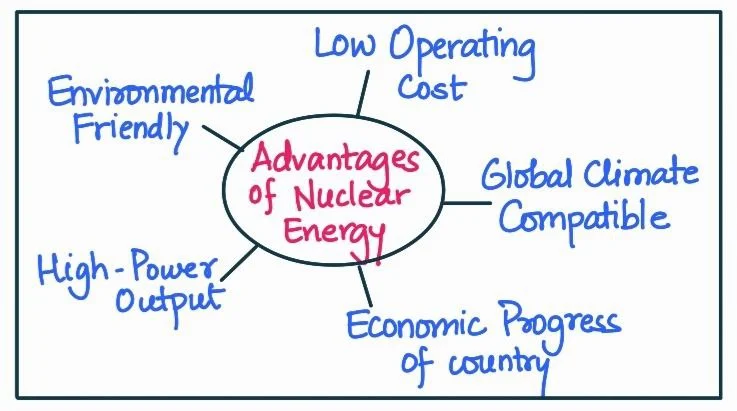Answer:
| Approach:
Introduction
- Introduce the topic by mentioning India’s growing energy demands and the role nuclear energy could play. Also, acknowledge the mixed feelings towards expanding the nuclear energy program.
Body
- Discuss both the facts and fears associated with nuclear energy.
- Substantiate your points with appropriate examples.
Conclusion
- Conclude by reiterating the potential of nuclear energy in meeting India’s energy demands.
|
Introduction:
Initiated in the 1950s, commercial nuclear power has grown to supply 10% of global electricity through around 440 reactors, becoming the second largest source of low-carbon power. Moreover, over 50 countries employ nuclear energy in about 220 research reactors, broadening its applications to medical and industrial isotopes and training. Amidst this backdrop, India, as the world’s second most populous nation and third-largest energy consumer, faces escalating energy demands due to rapid economic and urban expansion. Thus, a diverse energy mix, inclusive of nuclear power, is vital for India to sustain its growth trajectory.
Body:
Nuclear energy has the potential to be a significant part of this energy mix due to several reasons:
- High Energy Potential: Nuclear plants, like the Kudankulam Nuclear Power Plant, showcase the ability to generate large amounts of energy from a relatively small infrastructure.
- Currently, KNPP houses two operational units each with a capacity of 1,000 MW, totaling 2,000 MW of electricity generation.
- However, the real potential of this plant lies in its expansion. The construction of units three and four commenced in 2017 with an aim to operationalize them by 2023 and 2024, respectively.
- Additionally, the fifth and sixth units are under construction as of 2021.
- Once all six units are commissioned, estimated by 2027, the power plant will have a combined capacity of 6,000 MW, making it the largest nuclear power station in India.
- Low Greenhouse Gas Emissions: As a low-carbon technology, nuclear energy contributed a mere 5% to India’s total greenhouse gas emissions in 2019, per the World Nuclear Association, while contributing 3.1% to India’s total electricity.
- Energy Security: Nuclear energy, leveraging India’s domestic thorium reserves, can enhance the nation’s energy security, as manifested in the three-stage nuclear power program.

However, the journey isn’t devoid of concerns:
National Policy Hurdles:
- Regulatory Framework: Despite significant improvements, the Atomic Energy Regulatory Board (AERB) has been criticized for its lack of autonomy from the government and the industry it regulates.
- Nuclear Accidents: The echoes of disasters like Chernobyl and Fukushima underscore the catastrophic potential of nuclear mishaps, instilling persistent fears among the Indian populace.
- High Initial Costs: The steep investment and lengthy gestation periods, as seen with the Kakrapar Atomic Power Station unit-3, remain deterrents in nuclear plant development.
- Nuclear Waste: The management of long-lived radioactive waste poses a significant challenge, with a comprehensive solution yet to be found.
- Public Acceptance: Gaining public acceptance for nuclear power projects can be challenging due to widespread apprehensions about nuclear safety and waste disposal.
International Policy Hurdles:
- Non-Proliferation Treaty: As a non-signatory to the Treaty on the Non-Proliferation of Nuclear Weapons (NPT), India faces constraints in acquiring nuclear technology and fuel from other countries.
- Nuclear Suppliers Group: India’s non-participant status in the Nuclear Suppliers Group (NSG), a multinational body that governs international nuclear trade, further restricts its access to global nuclear markets.
Conclusion:
The road to harnessing nuclear energy to satiate India’s energy needs and meet climate objectives is a challenging one, fraught with both opportunities and threats. Ensuring the safe and sustainable development of nuclear energy is a tightrope that requires strategic planning, advanced technology, and rigorous regulation. The key to unlocking its potential lies in balancing the harnessing of its remarkable power with meticulous risk management.
